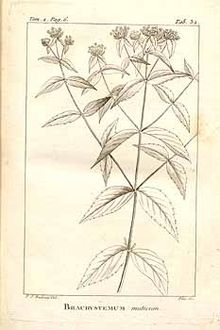He was appointed by Louis XVI as Royal botanist under the General Director of the Bâtiments du Roi and sent to the United States in 1785 with an annual salary of 2000 livres, to make the first organized investigation of plants that could be of value in French building and carpentry, medicine and agriculture. He traveled with his son Francois André (1770–1855) through Canada, and the United States. In 1786, he established and maintained for a decade, a Botanical Garden of 111 acres near what is now Aviation Avenue in North Charleston, South Carolina, from which he made many expeditions to various parts of North America, and another, of just under thirty acres, at Maisland in Bergen Township, New Jersey, on the Hudson Palisades across from New York, which was overseen by Pierre-Paul Saunier, from the Jardin des Plantes, Paris, who emigrated with Michaux.[4][5] Michaux described and named many North American species during this time. Between 1785-1791 he shipped ninety cases of plants and many seeds to France. At the same time he introduced many species to America from various parts of the world, including Camellia, tea-olive, and crepe myrtle.
After the collapse of the French monarchy, André Michaux, who was a royal botanist, lost his source of income. He actively lobbied the American Philosophical Society to support his next exploration. His efforts paid off and, in early 1793, Thomas Jefferson asked him to undertake an expedition of westward exploration, similar to the Lewis and Clark Expedition, the Corps of Discovery, conducted by Meriwether Lewis and William Clark a decade later. At the time of the planned Michaux expedition, Lewis was an 18-year-old protégé of Jefferson who asked to be included in the expedition, and was turned down by Jefferson.
Before Michaux set out, however, he volunteered to assist the French Minister to America, Edmond-Charles Genet. Genet was engaging in war-like acts against English and Spanish naval interests, aggravating relations between America, England and Spain. George Rogers Clark offered to organize and lead a militia to take over Louisiana territory from the Spanish. Michaux's mission was to evaluate Clark's plan and coordinate between Clark's actions and Genet's. Michaux went to Kentucky, but, without adequate funds, Clark was unable to raise the militia and the plan eventually folded. It is not true, as sometimes reported, that Thomas Jefferson ordered Michaux to leave the United States after he learned of his involvement with Genet. Though Jefferson did not support Genet's actions, he was aware of Genet's instructions for Michaux and even provided Michaux with letters of introduction to the Governor of Kentucky.[7]
On his return to France in 1796 he was shipwrecked, however most of his specimens survived. His two American gardens declined. Saunier, his salary unpaid, cultivated potatoes and hay and paid taxes on the New Jersey property, which is now still remembered as "The Frenchman's Garden", part of Machpelah Cemetery in North Bergen.
In 1800, Michaux sailed with Nicolas Baudin's expedition to Australia, but left the ship in Mauritius. He then went to Madagascar to investigate the flora of that island, and died there of a tropical fever. His work as a botanist was chiefly done in the field, and he added largely to what was previously known of the botany of the East and of America.[3]
In 1800, on his visit to the United States, Pierre Samuel Du Pont de Nemours, concerned about the abandoned botanical gardens, wrote to the Institut de France, who sent over Michaux's son François André Michaux to sell the properties. He sold the garden near Charleston, but the concern expressed by Du Pont and his brother Eleuthère Irénée du Pontpreserved the New Jersey garden in Saunier's care and continued to support it. Saunier continued to send seeds to France for the rest of his life, and is credited with introducing into gardens the chinquapin (Castanea pumila) and the smoking bean tree (Catalpa bignonioides).[8]
While Michaux is often said to have died in 1802 or 1803, Aaron Burr recorded meeting Michaux in Paris on Sept 17, 1810. According to Burr he went "to Michaux's, the botanist, who was many years in the United States, and has written a valuable little book of his travels. He is now publishing his account of our trees, which will be extremely interesting. It demonstrates that we (not the whole continent, but the United States alone) have three times the number of useful trees that Europe can boast..."

No comments:
Post a Comment